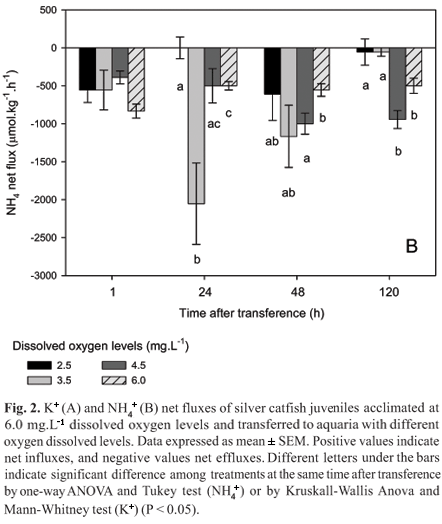Low dissolved oxygen levels in the water (hypoxia) can be provoked by oxygen consumption by fish and other organisms, organic matter decomposition, phytoplankton blooms, and temperature increase. The objective of the present study was to investigate Na+, Cl-, K+, and ammonia fluxes in silver catfish (Rhamdia quelen) exposed to different dissolved oxygen levels. Juveniles (9 ± 1g) maintained at 6.0 mg.L-1 dissolved oxygen were transferred to four 40 L aquaria with different dissolved oxygen levels (in mg.L-1): 6.0, 4.5, 3.5, and 2.5. In another series of experiments, juveniles were acclimated at 6.0 or 2.5 mg.L-1 dissolved oxygen levels, and then placed in two 40 L aquaria with 6.0 mg.L-1 dissolved oxygen. For both series of experiments, 1, 24, 48 or 120 h after transference juveniles were placed in individual chambers of 200 mL (with the same dissolved oxygen levels of their respective aquaria) for 3 h. Water samples were collected for analysis of Na+, Cl-, K+, and ammonia levels. The obtained results allow concluding that exposure to 2.5 mg.L-1 dissolved oxygen levels promotes loss of ions and lower ammonia excretion in silver catfish juveniles, but these losses are rapidly stabilized for Na+ and Cl-. Exposure to less hypoxic levels also changes ion fluxes and ammonia excretion, but there is no clear relationship between both parameters in this species. Therefore, silver catfish osmoregulation seems to be affected when this species is transferred from normoxic to hypoxic waters and vice-versa.
Oxygen saturation; Osmoregulation; Jundiá








